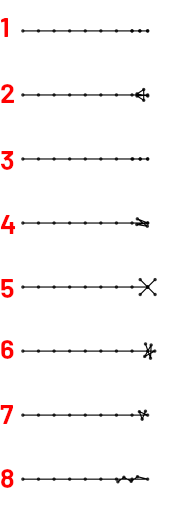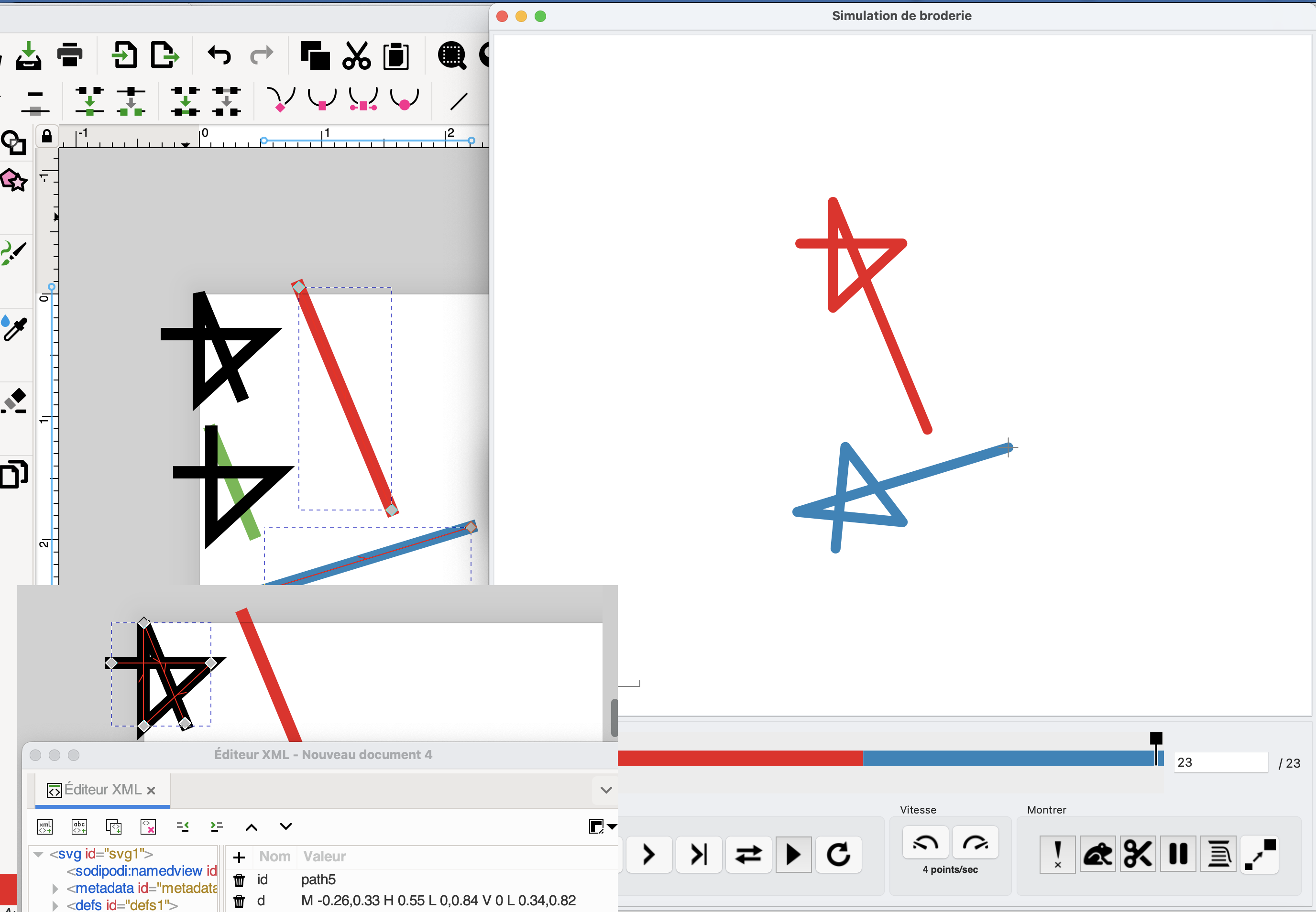Vernähstiche
Beschreibung
An- und Verstecher sind kleine Stiche am Anfang (Anstecher) oder am Ende (Verstecher) eines Farbblocks oder vor und nach einem Sprungstich oder Fadenschnitt-Befehl. Sie helfen den Faden zu sichern.
Einflussfaktoren (Wann werden Vernähstiche gesetzt)
Eine Stickdatei enthält eine Abfolge an Stickobjekten, die nacheinander ausgestickt werden. Vernähstiche werden gesetzt, wenn zwischen den Objekten ein Farbwechsel, ein Fadenschnittbefehl oder ein großer Abstand besteht. Mit Vernähstiche zulassen kann die Verwendung von Vernähstichen verhindert werden, mit „Vernähstiche erzwingen“ wird sichergestellt, dass diese vorhanden sind.
Minimum Jump Stitch Length
Der Wert für die Minimale Sprungstichlänge kann unter Erweiterungen > Ink/Stitch > Einstellungen oder objektbezogen im Parameterdialog eingestellt werden.
Der Wert definiert, ob der Stich zwischen zwei Objekten ein Sprungstich oder ein normaler Stich ist.
Nur wenn der Abstand zwischen zwei Objekten größer ist, als der Wert für die Minimale Sprungstichlänge, wird ein Sprungstich angewendet. Nur wenn ein Sprungstich verwendet wird, werden am Ende des ersten Objekts Verstecher und am Anfang des zweiten Objekts Anstecher hinzugefügt.
Es gibt jedoch noch weitere Parameter, die Einfluss darauf haben können, ob Vernähstiche verwendet werden.
Farbwechsel
Vor und nach einem Farbwechsel werden Verriegelungsstiche gesetzt.
Fadenschnittbefehle
Ink/Stitch fügt in das Objekt mit dem Fadenschnittbefehl Verstecher und in das darauf folgende Objekt Anstecher ein.
Fadenschnittbefehle können auf zwei Arten eingefügt werden:
- entweder als visueller Befehl übr
Erweiterungen > Ink/Stitch > Befehle > Objektbefehle hinzufügen ... - oder im Parameter-Dialog mit dem aktivieren der
Fadenschnitt-Checkbox
Vernähstiche erlauben
Vernähstiche erlauben kann An- und/oder Verstecher unterdrücken, wenn sie normalerweise angewendet würden.
Der Parameter Vernähstiche erlauben kann Vernähstiche vor oder nach dem Objekt (oder beides) verhindern. Wenn also der Abstand zwischen zwei Objekten groß genug für einen Sprungstich ist, aber das erste Objekt den Parameter Vernähstiche erlauben auf Anfang eingestellt hat, werden am Ende dieses Objekts keine Verstecher gesetzt.
Vernähstiche erzwingen
Es ist jedoch möglich, An- und Verstecher auch für Objekte mit geringen Abständen zu erzwingen. Aktiviere den Parameter „Vernähstiche erzwingen“, um Verriegelungsstiche zu erzwingen. Das folgende Objekt erhält dadurch automatisch auch Anstecher.
Achten Sie darauf, dass Sie „Vernähstiche erzwingen“ nicht für das zweite Objekt aktivieren, da Sie dann die „Verriegelungsstiche“ dafür erzwingen würden, nicht die „Heftstiche“, und Sie würden außerdem Verriegelungsstiche für das nächste Objekt erzwingen, unabhängig von dessen Abstand zum Objekt nach dem Sprung.
Vernähstiche erzwingen wendet unabhöngig vom Abstand immer Verstecher an. Diese Option überschreibt auch die Einstellungen für Vernähen erlauben.
Arten von Vernähstichen
Ink/Stitch bietet verschiedene Vernähstich-Typen an und erlaubt sogar die Definition eigener Vernähstiche.
Standard-Vernähstiche

- Halbstich. Dies ist der Standartwert und die einzige Option für Vernähstiche älterer Ink/Stitch Versionen. Eine Skalierung ist nicht möglich, da sich dieser Stich an der Stichlänge des Elements orientiert: zwei halbe Stiche zurück, zwei halbe Stiche nach vorn.
- Pfeil, skaliert in %
- Vor und zurück, skaliert in mm
- Schleife, skaliert in %
- Kreuz, skaliert in %
- Stern, skaliert in %
- Dreieck, skaliert in %
- Zick-Zack, skaliert in %
- Benutzerdefiniert. Skaliert in % oder mm abhängig von der eingegebenen Pfad-Variante.
Benutzerdefinierte Vernähstiche
Benutzerdefinierte Vernähstiche können entweder als SVG-Pfad definiert werden (skaliert in %) oder durch relative Schritte die sich nach der mm Angabe skalieren.
Benutzerdefinierter SVG-Pfad
Der SVG-Pfad wird immer so abgebildet, als ob er ein Pfad für einen Anstecher ist. Wird er als Verstecher genutzt dreht sich der Pfad automatisch um.
Der letzte Knoten des Pfades wird nicht gestickt, sondern dient lediglich als Richtungsangabe wie sich der Pfad an den Ursprungspfad anschließen soll.
Zum Beispiel wird ein Vernähstich in Form eines Dreiecks mit folgendem Pfad realisiert M -0.26,0.33 H 0.55 L 0,0.84 V 0 L 0.34,0.82 (das ist das d-Attribute des Pfades) Auf dem Bild sind dies die schwarzen Pfade. In einer Kopie ist das letzte Segment grün markiert.

Beide Pfade (rot und blau) haben einen Dreieck-Anstecher.
Der benutzerdefinierte SVG-Pfad wird so rotiert, dass das letzte Segment (grün) in die gleiche Richtung zeigt, in der der eigentliche Pfad (rot und blau) beginnt. Das letzte Segment dient nur dazu, die Richtung festzulegen. Es ist nicht teil des Vernähstichs und wird nicht gestickt.
Benutzerdefinierter Pfad in mm
Benutzerdefinierte Werte für die absolute Skalierung in mm werden mit einem Leerzeichen getrennt. Beispielsweise wird ein Pfad mit den Werten 1 1 -1 -1 und einer Skalierungsangabe von 0.7 mm zweimal 0.7 mm vorwärts wandern und zweimal 0.7 mm rückwärts. Dezimalwerth-Angaben sind möglich (z.B. 0.5 2.2 -0.5 - 2.2).



